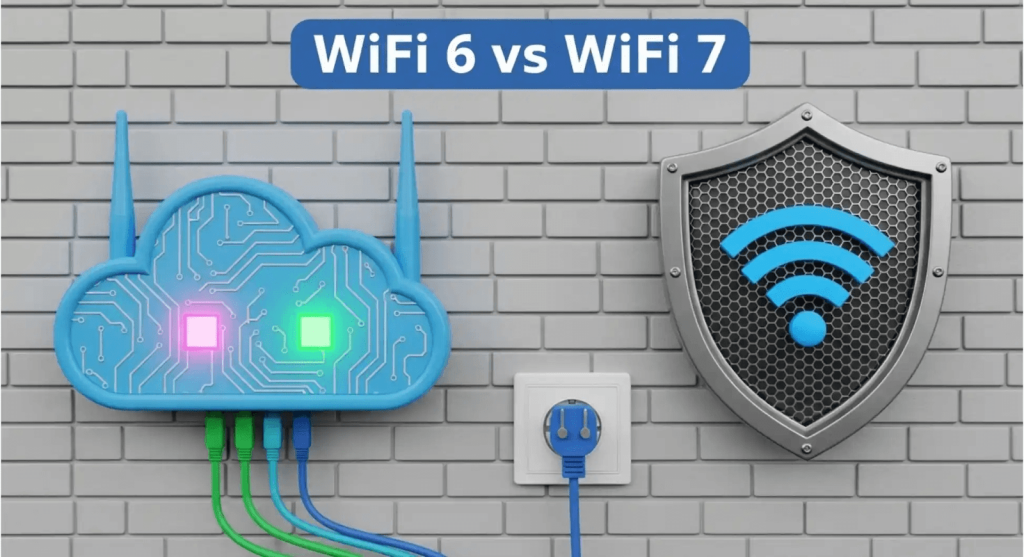Home WiFi has become as essential as electricity or running water. From streaming 4K content to powering smart home devices, our networks need to handle more demand than ever. That’s why new technologies like WiFi 6 and WiFi 7 are transforming the industry. These advanced standards promise faster speeds, lower latency, and the ability to connect more devices without slowdown. We will explore the future of home WiFi, explain the differences between WiFi 6 and WiFi 7, and discuss how consulting a professional WiFi technician can help you get the most out of these innovations.

What is WiFi 6?
WiFi 6, also known as 802.11ax, is the current standard for wireless networking. It was designed to handle the growing number of devices in modern homes.
Key Features of WiFi 6:
- Faster speeds: Up to 9.6 Gbps (compared to 3.5 Gbps on WiFi 5).
- Better efficiency: Handles multiple devices at once without lag.
- OFDMA technology: Splits channels to serve multiple devices simultaneously.
- Improved range: Stronger signals in crowded environments.
- Battery saving: Target Wake Time helps smart devices use less power.
For households filled with smart TVs, laptops, security cameras, and IoT gadgets, WiFi 6 provides smoother performance and less congestion.
What is WiFi 7?
WiFi 7 (802.11be) is the next-generation standard, expected to roll out widely by 2024–2025. It builds on WiFi 6 with groundbreaking upgrades.
Key Features of WiFi 7:
- Lightning speeds: Up to 46 Gbps, nearly five times faster than WiFi 6.
- Ultra-low latency: Ideal for AR/VR, gaming, and real-time applications.
- Wider channels: Uses 320 MHz channels for faster data transfer.
- Multi-Link Operation (MLO): Devices can connect across multiple frequency bands simultaneously for stronger reliability.
- Improved efficiency: Handles crowded environments like apartments and villas without slowdown.
WiFi 7 is designed for the future of connected living—think smart cities, 8K streaming, cloud gaming, and fully automated homes.
WiFi 6 vs. WiFi 7: A Quick Comparison
| Feature | WiFi 6 | WiFi 7 |
| Max Speed | 9.6 Gbps | 46 Gbps |
| Latency | Low | Ultra-low (sub-millisecond) |
| Channel Width | 160 MHz | 320 MHz |
| Multi-Device Handling | High | Even higher (with MLO) |
| Best Use | Homes with many devices | Advanced smart homes, AR/VR, 8K streaming |
Why These Upgrades Matter for Homeowners
- Streaming: Smooth 4K/8K video without buffering.
- Gaming: Ultra-low latency for competitive online gaming.
- Smart homes: Handle dozens of IoT devices without crashes.
- Remote work: Stable video calls, even with multiple users online.
- Future-proofing: Ensure your network stays relevant for the next decade.
Should You Upgrade Now?
- If you already struggle with slow speeds or congestion, WiFi 6 is a worthy upgrade today.
- If you’re building a smart home or want to future-proof your villa/apartment, waiting for WiFi 7 might be the smarter choice.
- Keep in mind: Your devices (phones, laptops, TVs) need to support these new standards to get the full benefits.
Challenges in Upgrading
- Cost: WiFi 6 and WiFi 7 routers are more expensive.
- Compatibility: Older devices may not fully utilize the new features.
- Setup complexity: Proper placement and configuration are crucial to get the promised speeds.
This is where a wifi technician can help.
Role of a WiFi Technician in the Upgrade
A skilled technician ensures:
- Correct router selection (WiFi 6 vs. WiFi 7) based on your needs.
- Professional installation for maximum coverage.
- Optimal placement of routers or mesh nodes in multi-floor homes.
- Security settings are configured properly to protect your data.
- Ongoing maintenance to keep your network future-ready.
Without expert guidance, many users fail to unlock the full potential of WiFi 6 and 7.
Conclusion
The future of home WiFi tech looks promising. With WiFi 6 already enhancing connectivity in busy households and WiFi 7 offering ultra-fast, highly reliable performance, homeowners can expect a whole new internet experience.







